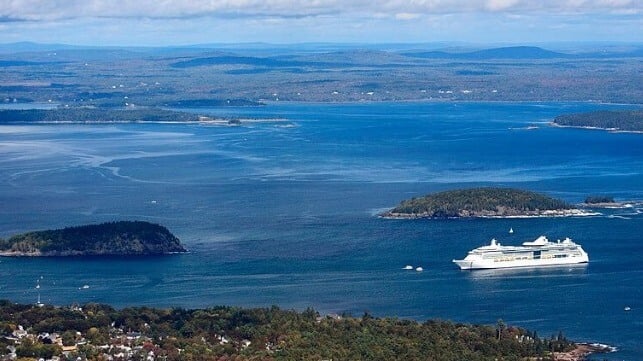Bar Harbor Votes to Dramatically Limit Cruise Passenger Arrivals

A public referendum on Tuesday’s ballot in the popular Maine tourist destination of Bar Harbor won strong support to dramatically reduce the limit on the number of cruise passengers visiting the small coastal town. Residents of the town, which has a population of just 5,500 people, argued that the expected 300,000 annual cruise ship visitors are overwhelming their streets and detract from hotel visitors who stay longer and spend more money on their trips. The vote brings to close a debate that had been raging in the town council and the local government’s efforts to create a compromise reducing the number of cruise ship visitors.
The town council had adopted regulations in September that called for a limit of between 3,500 and 3,800 passengers per day with no more than three cruise ships. Monthly limits ranged between 30,000 and 40,000 passengers and rose to 65,000 during the peak months of September and October. In adopting its regulations, the town council said the object was to better space out the cruise ships, lessen the intensity of the industry on the city, and provide for days as well as months with no cruise ship calls.
Voters strongly rejected the town council’s higher numbers and instead in a 58 percent to 42 percent vote (1,780 votes for vs. 1,273 votes against) adopted a citizens petition that limits the total daily number of cruise ship passengers to just 1,000 people. It also provides for a fine of $100 per passenger for each disembarking person exceeding the daily limit.
Bar Harbor is both a popular destination as well as a starting point for the cruise ship tours to neighboring Arcadia National Park. The buses carrying passengers to the park, which reported nearly 30,000 visitors in September, had become one of the most often concerns cited by residents. They also said the small streets and sidewalks become overcrowded with people while local merchants of course welcomed the influx of daily visitors.
The previous restriction set by the Town Council and its Cruise Ship Committee limited passengers to 3,500 people a day in July and August but increased to 5,500 passengers per day in May, June, September, and October. In presenting their citizens petition the sponsors argued that the existing limits “have proven to be insufficient to mitigate the impacts,” which they said created “a diminished quality of life for town residents.”
Due to the pandemic and later Canada’s decision not to reopen its ports till 2022, Bar Harbor did not have large cruise ship calls in either 2020 or 2021. The residents’ efforts to curtail cruise ships gained momentum during that pause in the business. In 2019, the town reported receiving 250,000 passengers and this year was expecting nearly 300,000. One of the problems cited by residents was the increasing size of the cruise ships and the number of calls in September and October during the fall foliage season which is when most cruise ships travel the New England coast. Almost all the large cruise ships visiting Bar Harbor now carry more than 1,000 passengers, not counting crew, meaning that the vote limits the port to only smaller, generally luxury cruise ships, and the coastal cruise ships.
Neighboring Portland, Maine about three hours driving distance south of Bar Harbor also had a referendum on its ballot on Tuesday. The city, which has a population about 12 times the size of Bar Harbor, overwhelmingly rejected the proposal to limit cruise ship calls.
The issue of overtourism is one that has plagued the cruise industry as it has rapidly expanded. Residents of small towns and popular destinations ranging from Key West, Florida to Juneau, Alaska have started efforts to limit cruise ship calls. The resident of Key West voted in a similar limit to Bar Harbor, but Florida’s governor later overruled the vote while the debate continues with the local government. Italy imposed a ban on large cruise ships from docking in Venice while Palma reached agreements with the cruise lines and Tahiti imposed limits at many of its ports.

that matters most
Get the latest maritime news delivered to your inbox daily.
The cruise lines argue they can stagger the arrival of their ships and coordinate among the different lines to manage the influx of tourists. The trade group Cruise Lines International Association also seeks to work with destinations to reach agreements on the level of passengers.
Photo by Ernst Krenger - CC BY 3.0 license
